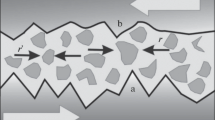Abstract
Aftershocks following a large earthquake are an inevitable part of the preparation and occurrence of large earthquakes. Depending on the location of the epicenter, tectonic–structural conditions of the epicentral zone, and earthquake intensity on the Earth’s surface, an aftershock cluster can cover different surface areas. Establishing the quantitative relationships between the aftershock zone and the main parameters of the earthquake (magnitude, rupture length, and slip value) can contribute to improving the model of an earthquake as a natural physical phenomenon. The extents of aftershock and deformation zones, as well as macroseismic changes on the Earth’s surface, indirectly indicate the intensity of the mainshock and the presence of portions with different degrees of weakening of rocks in the epicentral zone. This paper proposes a method to determine the area of such an aftershock zone using a deformational model of earthquake preparation and nucleation proposed earlier by the author. A new expression is obtained for determining the area of an aftershock zone depending on (i) the length of the rupture formed during the earthquake and (ii) the average slip along the rupture; expressions for the logarithmic and linear dependences of this area on the earthquake magnitude are also obtained. It is shown that the areas of the aftershock and deformation zones around an earthquake source are identical.







Similar content being viewed by others
REFERENCES
Cisternas, A., Philip, H., Bousquet, J.C., Cara, M., Deschamps, A., Dorbath, L., Dorbath, C., Haessler, H., Jimenez, E., Nercessian, A., Rivera, L., Romanowicz, B., Gvishiani, A., Shebalin, N.V., Aptekman, I., Arefiev, S., Borisov, B.A., Gorshkov, A., Graizer, V., Lander, A., Pletnev, K., Rogozhin, A.I., and Tatevossian, R., The Spitak (Armenia) earthquake of 7 December 1988: Field observations, seismology and tectonics, Nature, 1989, vol. 339, pp. 675–679. https://doi.org/10.1038/339675a0
Dambara, T., A revised relation between the area of the crustal deformation associated with an earthquake and its magnitude, Rep. Coord. Commun. Earthquake Predict., 1979, vol. 21, pp. 167–169.
Kasakhara, K., Mekhanika zemletryasenii (Mechanics of Earthquakes), Moscow: Mir, 1985.
Khachiyan, E.E., On a simple method for determining the potential strain energy stored in the earth before a large earthquake, J. Volcanol. Seismol., 2011, no. 4, p. 286. https://doi.org/10.1134/S0742046311040038
Khachiyan, E.E., Method for determining the potential strain energy stored in the earth before a large earthquake, Earth Sci., 2013, vol. 2, no. 2, pp. 47–57. https://doi.org/10.11648/j.earth.20130202.14
Khachiyan, E., Method for determining the ultimate strain for rocks of the Earth’s crust from the magnitude of relative slips on the Earth’s surface after a strong earthquake, Seism. Instrum., 2018, vol. 54, pp. 175–183. https://doi.org/10.3103/S0747923918020068
Mogi, K., Predskazanie zemletryasenii (Forecasting of Earthquakes), Moscow: Mir, 1988.
Rikitake, T., Predskazanie zemletryasenii (Forecasting of Earthquakes), Moscow: Mir, 1979.
Wells, D.L. and Coppersmith, K.J., New empirical relationships among magnitude, rupture length rupture width, rupture area, and surface displacement, Bull. Seismol. Soc. Am., 1994, vol. 84, no. 4, pp. 974–1002. https://doi.org/10.1785/BSSA0840040974
Author information
Authors and Affiliations
Corresponding author
Ethics declarations
The author declares that he has no conflicts of interest.
Additional information
Translated by N. Astafiev
About this article
Cite this article
Khachiyan, E.Y. On the Size of an Aftershock Zone of a Large Earthquake. Seism. Instr. 58, 601–609 (2022). https://doi.org/10.3103/S0747923922050073
Received:
Revised:
Accepted:
Published:
Issue Date:
DOI: https://doi.org/10.3103/S0747923922050073



